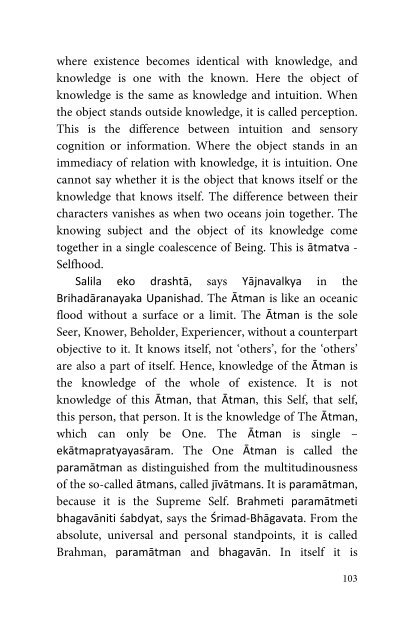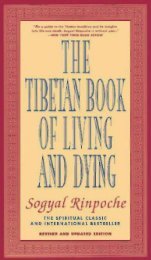etween Rāma and Rāvana? It was like the battle betweenRāma and Rāvana! This was all that the poet could say.“Space is like space, ocean is like ocean, and the Rāma-Rāvana-battle was like the Rāma-Rāvana-battle.” So, also,is the Ātman. The Ātman is like the Ātman. You cannot saythat the Ātman is like this, or that, because it isincomparable, and any comparison attempted would be areference made to something that has come out afterwardsas an effect. That would be a travesty of affairs, indeed.Therefore, it can be designated only asekātmapratyayasāram, the Essence of the consciousness ofSelfhood and Oneness. It is, if at all, definable by threeinteresting terms – ekatva (Oneness), ātmatva (Selfhood)and sāratva (Essentiality). It is the essence of all things, andit is One, and it is the Self. It is the Self, and, therefore, itcan only be One. It is the Self, and, therefore, it is theEssence. The Self is that which knows itself, not by a meansbut by its own existence. It is Existence knowing itselfwithout any external proof. Perception, inference, verbaltestimony, comparison, etc. do not apply here in the case ofthe knowledge of the Ātman. It cannot be inferred by logic,induction or deduction, and it cannot he perceived, itcannot be compared, it cannot be described by words. It isthe Self, which means that it is not beheld by someone else.The Self is beheld by itself alone. Here, Self and Existencemean one and the same thing. Existence is Self; Existence isthe Ātman. The Self is non-objectifiable, non-alienablefrom its own essence. The knowledge of the Ātman isintuition, which is a non-relational apprehension of Reality,independent of the operation of the senses and the mind,102
where existence becomes identical with knowledge, andknowledge is one with the known. Here the object ofknowledge is the same as knowledge and intuition. Whenthe object stands outside knowledge, it is called perception.This is the difference between intuition and sensorycognition or information. Where the object stands in animmediacy of relation with knowledge, it is intuition. Onecannot say whether it is the object that knows itself or theknowledge that knows itself. The difference between theircharacters vanishes as when two oceans join together. Theknowing subject and the object of its knowledge cometogether in a single coalescence of Being. This is ātmatva -Selfhood.Salila eko drashtā, says Yājnavalkya in theBrihadāranayaka <strong>Upanishad</strong>. The Ātman is like an oceanicflood without a surface or a limit. The Ātman is the soleSeer, Knower, Beholder, Experiencer, without a counterpartobjective to it. It knows itself, not ‘others’, for the ‘others’are also a part of itself. Hence, knowledge of the Ātman isthe knowledge of the whole of existence. It is notknowledge of this Ātman, that Ātman, this Self, that self,this person, that person. It is the knowledge of The Ātman,which can only be One. The Ātman is single –ekātmapratyayasāram. The One Ātman is called theparamātman as distinguished from the multitudinousnessof the so-called ātmans, called jīvātmans. It is paramātman,because it is the Supreme Self. Brahmeti paramātmetibhagavāniti śabdyat, says the Śrimad-Bhāgavata. From theabsolute, universal and personal standpoints, it is calledBrahman, paramātman and bhagavān. In itself it is103
- Page 1 and 2:
THE MĀNDŪKYAUPANISHADSWAMI KRISHN
- Page 3 and 4:
CONTENTSPublishers’ Preface ...
- Page 5 and 6:
INTRODUCTIONThe theme of the Manduk
- Page 7 and 8:
ceases to agitate the mind any more
- Page 9 and 10:
INVOCATION AND VERSESOm! Bhadram ka
- Page 11 and 12:
svapna-sthāno’ntaḥ-prajñaḥ
- Page 13 and 14:
8. This identical Ātman, or Self,
- Page 15 and 16:
THE PRANAVA OR OMKARAThe Vedas, in
- Page 17 and 18:
and rūpa, name as well as form. It
- Page 19 and 20:
Now, we come from what we call Īsv
- Page 21 and 22:
and to achieve this by a direct met
- Page 23 and 24:
structure and the glory of Om. With
- Page 25 and 26:
desire persisting, it would only po
- Page 27 and 28:
magnificence of Om, but how are we
- Page 29 and 30:
experience a thrill, as if an elect
- Page 31 and 32:
THE INDIVIDUAL AND THE ABSOLUTEThe
- Page 33 and 34:
vai tat. The reconciliation of “t
- Page 35 and 36:
yaccānyat trikālātitam tadapyomk
- Page 37 and 38:
The ultimate longing of all aspirin
- Page 39 and 40:
to the realisation of asti-bhāti-p
- Page 41 and 42:
structural difference is an effect
- Page 43 and 44:
self is the false self, not the rea
- Page 45 and 46:
cow, with four feet? The four feet
- Page 47 and 48:
Consciousness. A study of conscious
- Page 49 and 50:
THE UNIVERSAL VAIŚVĀNARAThis Ātm
- Page 51 and 52: these dealings are with ‘other’
- Page 53 and 54: the Virāt, or the Universal Person
- Page 55 and 56: logical discrimination. This is the
- Page 57 and 58: it were. This is the function of th
- Page 59 and 60: world’s existence, not merely a p
- Page 61 and 62: subtle body is not visible to us, a
- Page 63 and 64: Now, we consider the meaning of bah
- Page 65 and 66: ecause the consciousness of the jī
- Page 67 and 68: cannot have power over things. We a
- Page 69 and 70: we have about the dream world in re
- Page 71 and 72: is a complicated case for investiga
- Page 73 and 74: never pass such a judgment. You are
- Page 75 and 76: are in a particular state, that sta
- Page 77 and 78: But, if you feel that by waking up
- Page 79 and 80: The dream consciousness which is ta
- Page 81 and 82: ecause freewill is only as much rea
- Page 83 and 84: Dreams, therefore, are due to repre
- Page 85 and 86: egarded as pravivikta, sūkṣhma,
- Page 87 and 88: The third foot of the Ātman the th
- Page 89 and 90: ānanda, swallow ānanda, consume
- Page 91 and 92: Causal Condition, known as Īsvara.
- Page 93 and 94: ocean is being described here, the
- Page 95 and 96: of an effect, namely, the plant, an
- Page 97 and 98: Īsvara’s Being. For Him, it is a
- Page 99 and 100: or Destroyer, more than a cause of
- Page 101: which you have seen, heard, etc.? B
- Page 105 and 106: simply are. You have become That, a
- Page 107 and 108: peaceful. But the peace of the Ātm
- Page 109 and 110: seen the Ātman? Can you get the Ā
- Page 111 and 112: THE ĀTMAN AS THE PRANAVAThe Ātman
- Page 113 and 114: the Ātman in the waking state is c
- Page 115 and 116: symbolic, as the comparison of Brah
- Page 117 and 118: Therefore, your generation, your po
- Page 119 and 120: the deep sleep state, even as all o
- Page 121 and 122: elationless. Samviśatyatmanātmān



